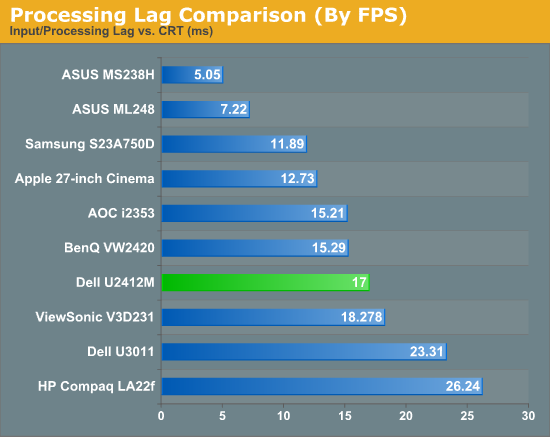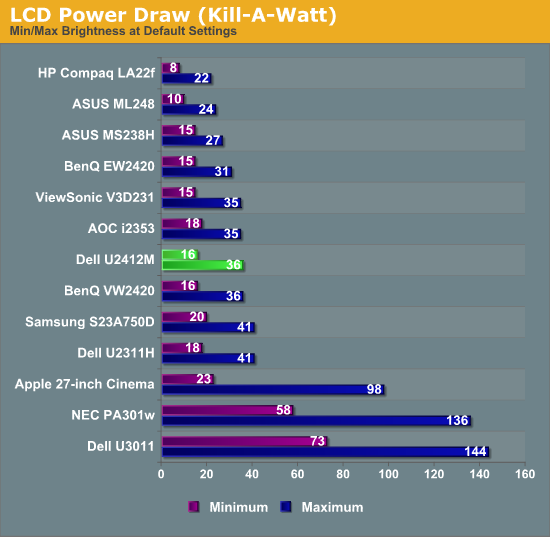Dell U2412M - 16:10 IPS without Breaking the Bank
by Chris Heinonen on February 28, 2012 9:00 AM ESTDell U2412M Input Lag and Power Use
For testing lag, I am trying a new solution to our previous testing method. I’m trying out SMTT, which is designed specifically for measuring lag in LCD displays. Using DirectX it manages to push over 1,000 frames per second to a display, allowing for millisecond accuracy instead of relying on time demos that often run well below that threshold. Using this method, we can actually determine two different values: The input lag for the LCD to initially respond, and then the total lag from when the new frame is received to when it is completely drawn and at full brightness. This last one is the overall important value, as it is what gamers would be most concerned with. It’s important to have as low an "input lag" as possible so that even if the screen isn’t fully drawn yet (the pixels will be changing over) you will be able to begin to get that feeling of responsiveness.

Here we see that the overall lag value measured OK, at 17ms. The input lag, which was also measured, was just under 2ms, which indicates that the Dell responds very quickly, and then it’s just a matter of the pixel response time. One thing to keep in mind here is that the 17ms response time is the total time from input to peak brightness, and then it takes 15ms to fall back to another value. When I actually look at the test subjectively and not objectively, you can certainly see the change in the pixel after 7-8ms of time. So I could report it as 8ms of lag, as that’s about what I think you would experience in a real world situation, but the worst case scenario seems to be 17ms, which is what I’m choosing to report as that’s the objective number.
The CRT still comes in perfect, and that’s what the LCD should aim to do; picking a number that gives a better result, even if it might be more applicable to the real world, feels like cheating. Perhaps we will get a future display technology (like OLED or CrystalLED that I saw at CES this year) that will bring us back to CRT response times, but until that happens I’m going with the objective, worst case measurement. I will report the “real world estimate” along with it, though, so you can use that for your own judgment. Please let me know what you think of this in the comments section.
I made the assumption that with a larger panel and the 300 nits of light output that the Dell would not be the most eco friendly panel I had seen. Happily I found this to not be the case. It drew just 36 watts at maximum brightness and only 16W at minimum brightness, less than even the 23” Dell U2311H from last year. I don’t know if it is more efficient LED lights, or a more transparent panel that allows more light through, but Dell did a good job keeping the power use low on the U2412M.











143 Comments
View All Comments
Touche - Wednesday, February 29, 2012 - link
+1000cheinonen - Wednesday, February 29, 2012 - link
Measuring the refresh rate of the backlight is on the list of things to try to do going forward. It should be added soon, though I'm not certain if it will be in the next couple of reviews or not.Zolcos - Tuesday, February 28, 2012 - link
It's reassuring to see this product, not just because of 16:10 but other good-yet-all-too-rare choices like anti-glare, displayport, and a relatively non-shiny bezel.Personally, I'm still holding out for 120hz at any resolution better than 1080p. If a monitor with the exact same feature set and resolution as the one in this review came out with 120hz, I'd literally buy it today, even if it was TN and cost twice as much.
That's my realistic side anyway. I still have dreams of 1920x1440 since widescreen (while great on its own) is an inefficient use of space for multi-monitor setups, but that's another debate entirely.
Zds - Tuesday, February 28, 2012 - link
The main advantage of the HP unit is not S- but 8bit colors. IPS vs. S-IPS is not crucial, 16.7M real colors can be.Oxford Guy - Tuesday, February 28, 2012 - link
6-bit vs. 8-bit isn't the whole story, either.The other part of the story is how wide a gamut the backlight can provide.
James5mith - Tuesday, February 28, 2012 - link
"I can criticize the black uniformity as the corners were a bit bad, though being a lot better in this area will likely require going to an LED backlighting system or the emergence of OLED displays for the desktop, both of which are very expensive compared to this."http://accessories.us.dell.com/sna/productdetail.a...
First line of the information: "Enjoy widescreen performance, any way you want it. With a 24" 16:10 panel, IPS technology and LED backlight, the U2412M provides a brilliant view, plus amazing adjustability to suit any style."
So the LED backlight isn't helping it to get any better. It's already there, and apparently not very good.
JarredWalton - Tuesday, February 28, 2012 - link
The point was to use something other than edge LED backlighting, though that's not entirely clear from the wording. I'll see if I can fix that...Zoomer - Tuesday, February 28, 2012 - link
How about reviewing this or a similar monitor? Now that is real bare bones, and real cheap. $400 or $250 for a 27" H-IPS if AT has some friends in Korea.http://www.overclock.net/t/1215866/reviewed-400-25...
frombauer - Tuesday, February 28, 2012 - link
Would this be better in lag and response time compared to the Dell 2209WA? I own this one, and it's good enough for gaming to me. But I wanted more resolution.Touche - Tuesday, February 28, 2012 - link
Get a Sony GDM-FW900 :)